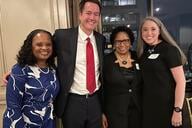You have /5 articles left.
Sign up for a free account or log in.
A large part of a communications professional’s job is scoping, editing and placing pieces in the media written by faculty and administrators. And we can’t do our jobs well unless faculty are willing to give of their time and expertise and work with us.
There are many who don’t want to engage for a variety of reasons -- too busy, bad past experience with media (or with a comms team), too nervous, not enough confidence. To get buy-in from these faculty and administrators, you must start by building a relationship and trust; without that connection, your job will be impossible. Figure out what their experiences have been with communications and the media and what their expectations are for partnership with you.
Sometimes, professors will engage with you, but their approach may throw a wrench in your ideal process. Perhaps the timing is off, or their writing is more appropriate for an academic audience instead of mainstream media. Or maybe they’re getting hung up in the review process and it makes it difficult to move pieces forward. When this happens, taking extra care to handle the interaction will go a long way to preserve the relationship. Here are some tips to help you navigate some tricky scenarios.
When we get a written piece from a faculty member that we weren’t anticipating, along with high expectations for a quick placement, we like to start with a phone call to the professor; it can be easier to talk things out rather than respond in an email, where words and punctuation can be misconstrued. Find out what the goal of the piece is, whom the audience is and whether the angle works as is or needs to be adjusted. Set realistic expectations for the piece; if it will not appeal to a national business publication but is a fit for your local paper, be up front about it.
Many times, we’ll open a draft that was pegged to a news event from days ago. The story isn’t progressing, so what can you do with an already dated op-ed? If there is a way to move the story forward and there is an angle that has not been covered, you may be able to rework the piece, but if it’s already old news, tell the person honestly. With this never-ending news cycle, it could be a piece that you save for when the next news event happens, and you just have to update the introduction. For example, we worked with a faculty member on a piece about President Trump criticizing PBS’s Yamiche Alcindor during a press conference; although it was a bit late for this news event, a couple months later Ida B. Wells won the Pulitzer Prize posthumously and we were able to tweak the introduction and run the piece.
Some faculty find the transition from academic writing challenging. But when they teach, they regularly break down complex material for students; they can do the same for the general public. Help your faculty identify the audience they are writing for and encourage them to cater to this group. Send them pieces the media outlet has run for background. One outlet we love to work with is The Conversation. One of the tools they use when faculty write for them is a color-coded dashboard letting them know if their words are understandable or too academic. It’s great for faculty just starting out as well as faculty who are seasoned writers.
For administrators, faculty and staff who have shown an interest in writing but may still resist any feedback, there are a few steps you can take as you review their pieces. First, make any minor formatting changes (think incorrectly spaced dashes, double spaces after periods, font or size inconsistencies) without tracking changes. These small changes can often overwhelm the document -- and the writer getting the revisions -- and they can still be accessed in the document’s history if anyone really needs to see them. Similarly, you can opt to send two versions back for review, a clean copy and one with your markup; you can also suggest reviewing with simple markup only so that the minutiae of editing don’t overwhelm the draft.
We like to make comments that include suggestions for changes and rationale rather than just making the changes in the document, especially when we’re working with someone for the first time and we’re still building a relationship. If you’re dealing with someone resistant to feedback, this can also be helpful because it puts the revisions back on their plate and lets them use their own language to make the changes. As you develop their trust, they’ll be more likely to accept your suggestions and be more open to your direct edits.
While your goal is to make a draft as strong as possible, it’s also important to know your limits. Some pieces are not going to work, some advice and edits will be ignored, and some people are just not going to want to work with you. But there is no shortage of potential partnerships on campus. If you can get buy-in from the top down and have the president or dean send a thank-you to the faculty member, as well as sharing the piece with colleagues, it helps encourage future participation because it frames the partnership with comms as something worthwhile for the college and to individuals. Although faculty and administrators might bristle at your open and honest feedback right away, if you can build strong relationships and gain trust while demonstrating the value of working with you, over time they will come to appreciate it. After all, it’s your job to help land placements with strong pieces that make them look good.
Cristal Steuer is a senior strategist and Ali Lincoln is the director of thought leadership at TVP Communications.




